Wednesday 1 November, 2006, 16:47 - Radio Randomness
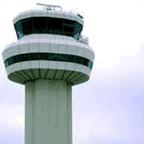 As if this site isn't littered with enough useless information already, here's a load more. Having travelled to and from the various London airports on a number of occasions, I thought it would be nice to have an up-to-date list of the various air traffic control frequencies used at them (so that whilst en-route to the airport or waiting in the lounge I could tune-in to see exactly how delayed my flight is). Using the all-knowing Google proved rather confusing as lots and lots of differing lists appeared, so I decided to compile the lists together and then take a listen to see which channels were clearly active and which were now obsolete.
As if this site isn't littered with enough useless information already, here's a load more. Having travelled to and from the various London airports on a number of occasions, I thought it would be nice to have an up-to-date list of the various air traffic control frequencies used at them (so that whilst en-route to the airport or waiting in the lounge I could tune-in to see exactly how delayed my flight is). Using the all-knowing Google proved rather confusing as lots and lots of differing lists appeared, so I decided to compile the lists together and then take a listen to see which channels were clearly active and which were now obsolete.The results are posted below and only those frequencies heard to be active during random monitoring sessions in October 2006 are listed. The frequencies shown in italics were listed on a number of sites (sufficient to believe that they are for real) but monitoring showed that there was no activity, so they're listed just in case! All frequencies are in MHz.
 London Heathrow Airport
London Heathrow AirportApproach 119.725 134.975
Radar 120.400
Tower 118.500 (Departures) 118.700 (Arrivals)
Ground 121.900 121.700
Clearance 121.975
ATIS 121.850 (Departures) 128.075 (Arrivals)
London Gatwick Airport
Approach 126.825
Director 118.950
Tower 124.225
Ground 121.800
Clearance 121.950
ATIS 136.525
London City Airport
Tower 118.075
ATIS 136.350
London Volmet
Main 135.375
North 126.600
South 128.600
Other London Airports/Frequencies
Battersea Heliport 122.900
Thames Radar 132.700 (also used as Approach for London City Airport)
London VFR 125.625 (Visual Flight Rules)
London FIS 124.600 124.750 (Flight Information Service)
So there you have it. Together with a cheap airband scanner, you now have the knowledge required to depress yourself by listening in to flight controllers and discovering exactly how late your flight really is!
1 comment
( 2813 views )
| permalink
| 



 ( 2.9 / 9844 )
( 2.9 / 9844 )




 ( 2.9 / 9844 )
( 2.9 / 9844 )
Thursday 5 October, 2006, 11:39 - Spectrum Management
 Something that's always been a nuisance is that the International Telecommunications Union (ITU) has made it's frequency allocation tables (i.e. the table which shows which frequencies are allocated to which services in which countries) something that has to be paid for if you want a full copy. The 'ITU Radio Regulations' is a large set of documents that describe radio usage and the heart of it is a set of 3 regional tables that allocate frequencies to specific uses and currently costs 252 Swiss Francs (about GBP107 at today's exchange rate).
Something that's always been a nuisance is that the International Telecommunications Union (ITU) has made it's frequency allocation tables (i.e. the table which shows which frequencies are allocated to which services in which countries) something that has to be paid for if you want a full copy. The 'ITU Radio Regulations' is a large set of documents that describe radio usage and the heart of it is a set of 3 regional tables that allocate frequencies to specific uses and currently costs 252 Swiss Francs (about GBP107 at today's exchange rate). 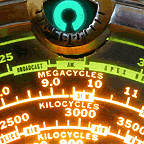 If you just want to know whether fixed links have an allocation at 8 GHz in France, that's rather a lot to pay.
If you just want to know whether fixed links have an allocation at 8 GHz in France, that's rather a lot to pay.I was delighted, therefore, to discover that the Region 1 (Europe, Africa, the Middle East and Asiatic Russia) and Region 3 (Asia and Australasia) information can now be access for free on the web-site of telecommunications consultants 'InterConnect Communications'. Their Electronic Frequency Allocation Table (E-FAT) service allows you to query the ITU tables viewing either the whole table or just the allocations to specific services.
A similar service, but only for specific European countries (well certain CEPT members) is provided by the European Communications Office (ECO) in the form of their European Frequency Information Services (EFIS).
Dead handy!
Thursday 21 September, 2006, 15:40 - Amateur Radio
Most day-to-day 'DX' propagation experienced by radio users at VHF and UHF frequencies relies on some interaction between their signal and the troposphere (the troposphere is the lower layers of the atmosphere extending up to about 10 miles above sea level). For anyone wanting to find out more about the different modes of tropospheric propagation, there is an excellent article by William Hepburn that describes them all. 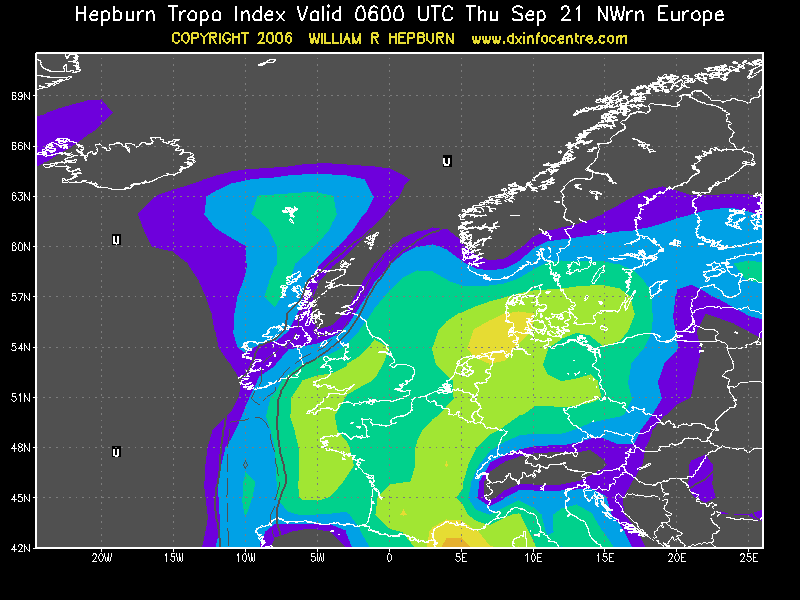 The same web-site also gives 5 day predictions as to the possible level of tropospheric propagation that can be expected too - very interesting.
The same web-site also gives 5 day predictions as to the possible level of tropospheric propagation that can be expected too - very interesting.Having recently installed a simple VHF antenna on my house, I thought I'd do the usual thing and tune around the various amateur repeaters to see what kind of coverage I was achieving. According to predictions that I had done, I expected to be able to just about receive transmitters from a maximum of 80 miles away (my location is nothing special). I was a bit surprised to discover that I could regularly hear stations from around 150 miles (225 km) away on 2 metres (145 MHz) and similar distance but less commonly on 70 cm (433 MHz). Indeed with the radio on in the background whilst working one day, a number of repeaters on the same channel at distances of around 150 miles faded in and out with alarming regularity.
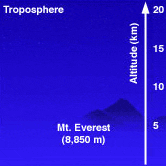 Of course the culprit in extending my range in this way is the troposphere (together with the fact that most amateur repeaters tend to be high up to give wide coverage to start with). It would seem that, even on an almost 'flat' day, there is enough going on in the atmosphere to enhance reception (and transmission) even for a fairly simple set-up in a fairly average location.
Of course the culprit in extending my range in this way is the troposphere (together with the fact that most amateur repeaters tend to be high up to give wide coverage to start with). It would seem that, even on an almost 'flat' day, there is enough going on in the atmosphere to enhance reception (and transmission) even for a fairly simple set-up in a fairly average location.Now from an amateur radio perspective, this is great fun. From a 'professional' radio user's perspective this must prove a nightmare. Typically VHF frequencies will be re-used witin about a 80 mile radius, so that under totally flat conditions there is theoretically no potential for interference. However if 'tropogation' is as common as it would appear to be from my location, the levels of interference between commercial VHF (and to a lesser extent UHF) users must be a real nuisance - and there's nothing that can be done about it. Or is there...?
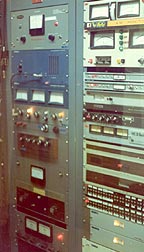 Some television transmitters employ a technique known as 'beam-tilt' which points the signal from a transmitter slightly below horizontal. Doing this limits the range of the transmitter whilst at the same time reducing interference further away and producing a slightly stronger signal in the wanted coverage area. A beam-tilt of about 1 degree down from the horizon can make quite a difference. The problem is that it takes careful antenna design and often quite large and complex antennas to achieve beam-tilt so it isn't a solution for your average taxi company or security company.
Some television transmitters employ a technique known as 'beam-tilt' which points the signal from a transmitter slightly below horizontal. Doing this limits the range of the transmitter whilst at the same time reducing interference further away and producing a slightly stronger signal in the wanted coverage area. A beam-tilt of about 1 degree down from the horizon can make quite a difference. The problem is that it takes careful antenna design and often quite large and complex antennas to achieve beam-tilt so it isn't a solution for your average taxi company or security company.A solution which is within the financial reach of most users is something known as CTCSS. This encodes a sub-audible (i.e. silent) tone onto each transmitter. Only transmitters and receivers set to use the same tone can hear each other. Such a system stops receivers from falsely hearing interfering transmitters - always assuming that the interfering transmitter has a different CTCSS tone to the one you want to receive. CTCSS, however, wouldn't stop the signal from causing interference, just stop you from hearing it.
Anyway, none of this is a problem for me. I'm just happy that my humble set-up is providing hours of endless fun (hmmm... must find something better to do) as I hear distant repeaters come and go!
Wednesday 20 September, 2006, 12:08 - Licensed
 As anyone who has bought a new television in the UK in the past year or so will know, it is the Government's intention to close down all analogue TV transmitters by the end of the year 2012. It's main reason for doing this is to release some of the channels used for broadcasting so that they can be used for 'new users' (presumably ones that they see as being more lucrative!)
As anyone who has bought a new television in the UK in the past year or so will know, it is the Government's intention to close down all analogue TV transmitters by the end of the year 2012. It's main reason for doing this is to release some of the channels used for broadcasting so that they can be used for 'new users' (presumably ones that they see as being more lucrative!)The plan is for a rolling conversion of all television transmitters in the country to change from analogue to digital. In doing this, of the four existing analogue frequencies used to carry BBC1, BBC2, ITV1 and Channel 4, only three of these will continue to be used - one will be freed for the aforementioned mysterious new users. The three frequencies still in use will carry three digital mulitplexes ensuring national provision of all BBC, ITV, Channel 4 services including CBBC, BBC News 24, ITV2, ITV3, E4 and so on, so there's no need to worry about people losing their favourite programmes. At the 80 transmitter sites that already carry digital services of the 4 (or 5) analogue frequencies in use and the 6 digital frequencies in use, only 6 will remain in use, the remainder falling into the pot of those available for other users.
Once the digital switch-over (as it's know) is complete, only UHF channels 21 to 30 and 41 to 62 will still be available for television broadcasting. Channels 31 to 40 and 63 to 68 (and possibly 69) will be freed for new users. The diagram below illustrates this situation. 'S.A.B.' represents services ancilliary to broadcasting (sometimes known as programme making and special events) and includes radiomicrophones, talkback, remote control for cameras, point-to-point audio links - i.e. radio equipment used by people making programmes. Channel 69 is shown hashed as it's not yet clear whether or not it will be given over to new users or remain with S.A.B.
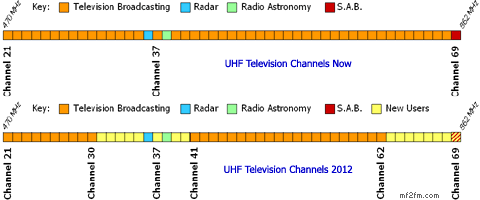
So how can the necessary channels be crammed into two-thirds of the original spectrum? There are now approximately 5,200 individual television transmitters on-air in the UK amounting to around 115 transmitters per available UHF TV channel. After switch-over the number of transmitters will be reduced to around 3,800 - but this has to be squeezed into only 32 channels amounting to around 118 transmitters per channel. So the number of transmitters per channel remains roughly the same, and therefore, in theory, planning the new network should be no more difficult than planning the old one was.
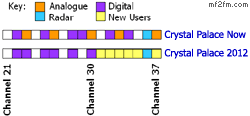 Let's take a look at a practical example, using the Crystal Palace television transmitter site which serves around 12 million people in and around London. At present channels 23, 26, 30, 33 and 37 are used for analogue transmissions and channels 22, 25, 28, 29, 32 and 34 are used for digital. Of these, channels 32, 33, 34 and 37 will no longer be available for broadcasting after switch-over as they are part of the channels set aside for new users.
Let's take a look at a practical example, using the Crystal Palace television transmitter site which serves around 12 million people in and around London. At present channels 23, 26, 30, 33 and 37 are used for analogue transmissions and channels 22, 25, 28, 29, 32 and 34 are used for digital. Of these, channels 32, 33, 34 and 37 will no longer be available for broadcasting after switch-over as they are part of the channels set aside for new users. So after switch-over, a combination of the existing analogue and digital channels (i.e. channels 22, 23, 25, 26, 28 and 30) will be used for the purely digital service. Thus the future all-digital transmissions can be squeezed into the remaining broadcasting channels at this particular transmitter site.
 This situation is also fine at the majority of UK transmitter sites including the smaller ones as typically at least 3 of the 4 channels in use at these smaller sites will fall within the untouched broadcast spectrum. Some jiggery-pokery will be necessary at a small number of sites to squash services into the remaining channels but all-in-all the plan works!
This situation is also fine at the majority of UK transmitter sites including the smaller ones as typically at least 3 of the 4 channels in use at these smaller sites will fall within the untouched broadcast spectrum. Some jiggery-pokery will be necessary at a small number of sites to squash services into the remaining channels but all-in-all the plan works!The question remains as to what 'new uses' might be made of the freed spectrum. One possiblity is that it might be used for more digital television (maybe mobile TV, portable TV or HD-TV). It might be used for more celluar services (maybe 4G). It might be used for mobile delivery of wireless broadband (maybe using 802.20). Some of it might be needed to house all the displaced S.A.B. users who currently occupy channel 69 (and to a lesser extent also heavily occupy channels 63 to 68). At present it's anyone's guess as to the need for and use of this spectrum but one thing is for certain, the UK Government will be rubbing their hands together in glee at the potential for raising a pot of gold for selling it.

